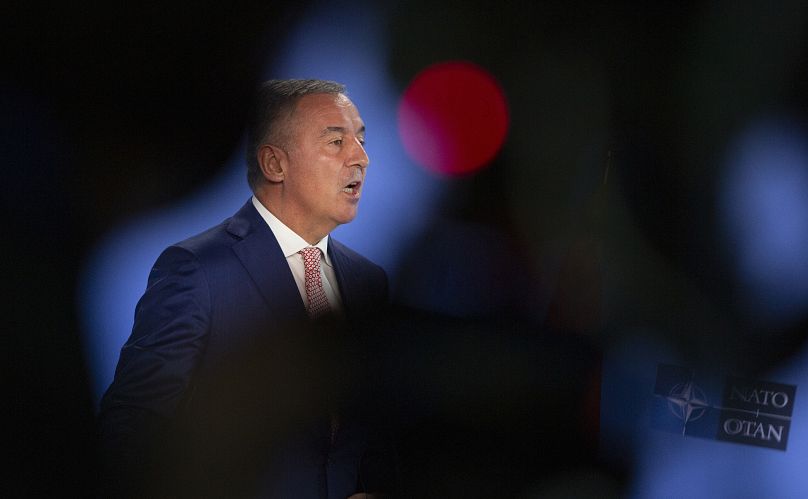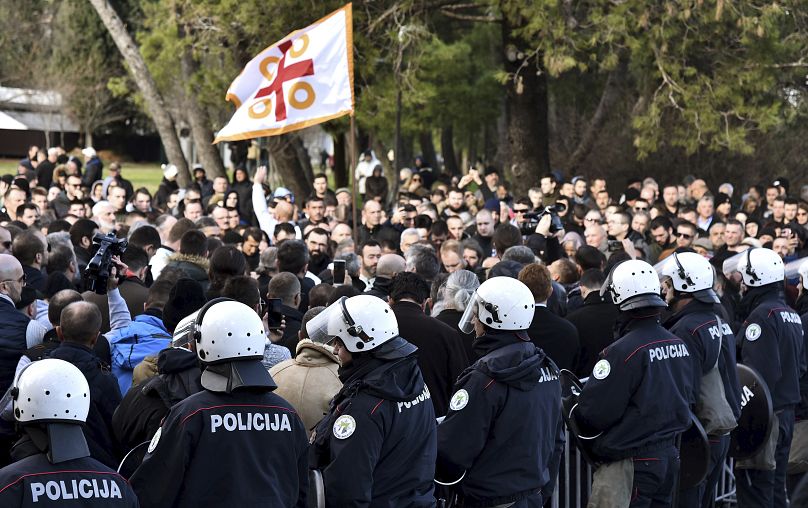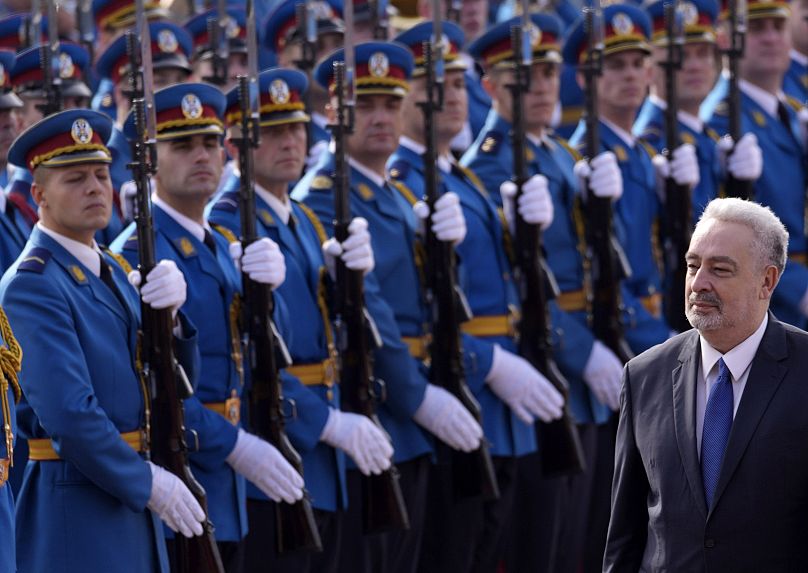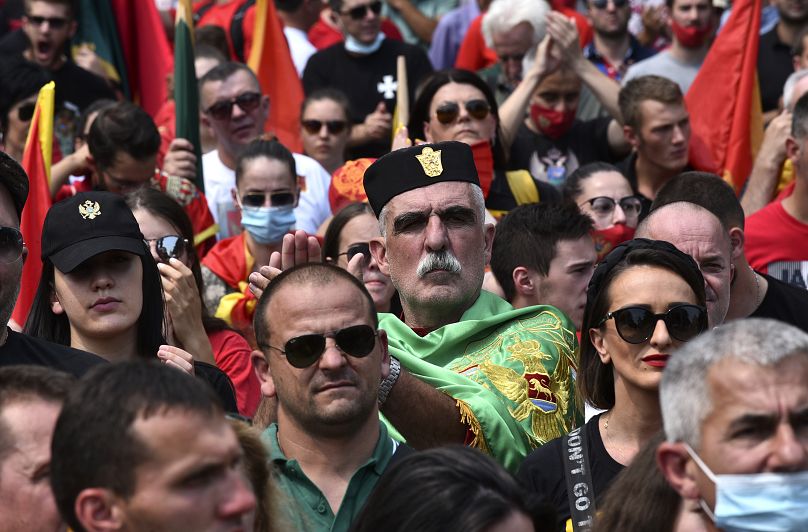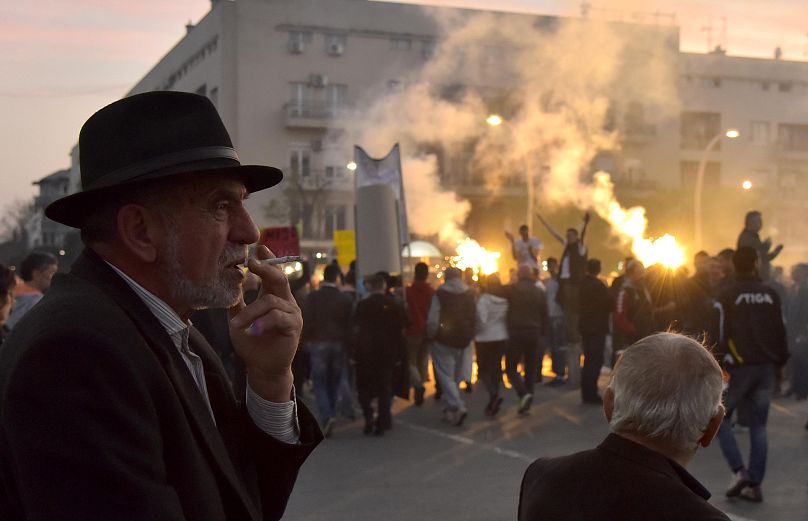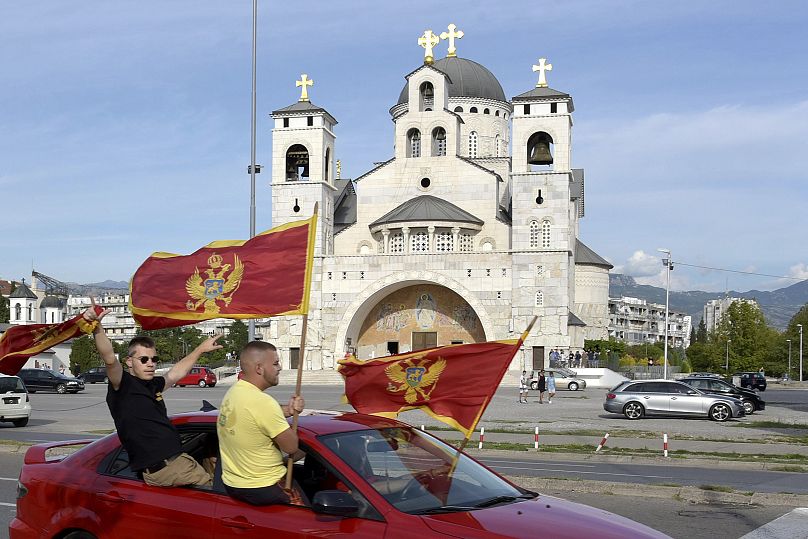Montenegro lurches back into political crisis as former allies try to oust PM
Both the deputy PM and the prime minister launched motion for a vote of no confidence in the country' parliament, with the latter not attempting to dissolve the parliament altogether, triggering snap election.
Montenegro’s government coalition is on the brink of collapse as the parties once united around dislodging corruption in the country are now at each other’s throats over ideological issues.
When the new Montenegrin government was inaugurated in December 2020, the leaders of three main coalitions that won the August elections were proud of pushing out the Democratic Party of Socialists (DPS), which had been in power for almost 30 years.
Yet a bit over a year in power has exposed the cracks between the main coalitions — the Future of Montenegro, Black and White and Peace Is Our Nation — over lack of progress, nationalism, and obstructionism.
On 19 January, deputy PM and the leader of the United Reform Action (URA) party Dritan Abazović filed a motion for a vote of no confidence against prime minister Zdravko Krivokapić and the rest of the government.
“This is an answer to the months-long crisis and the fact that the current Krivokapić government no longer has the support of the parliamentary majority,” Abazović told the local press.
In a press release, URA said they were spurred when three ministers refused to participate in a parliamentary interpellation or a motion to question the work of the government. Krivokapić flat out refused to consider it.
A civic movement turned political party, URA has positioned itself as the country’s only authentic civic movement.
It is the junior coalition partner in a government dominated by Krivokapić’s For the Future of Montenegro, a grand coalition where the majority of the power is held by Democratic Front (DF), a right-wing populist union of parties.
URA was expected to act as a corrective on the rest of the government, especially since they were the kingmakers in the last elections — providing Krivokapić and the rest with the necessary majority to form a government.
Krivokapić called URA’s parliamentary motion “a fraud,” filed his own request for a vote of no confidence against Abazović and proposed his party ally, Milojko Spajić, as the new deputy PM.
“For a healthy Montenegro,” Krivokapić exclaimed in a Twitter post.
Within 24 hours, he also filed a motion to prematurely dissolve the parliament, which would trigger a snap election. Each motion needs a majority of 41 votes to be passed in the 81-MP chamber.
Krivokapić also responded by going on a firing spree, removing Abazović from his post as the head of the national advisory board for the fight against corruption and foreign affairs minister Đorđe Radulović as the country’s main EU negotiator.
He also relieved the state secretary of the ministry of justice Boris Marić, and the state secretary for ecology, Danilo Mrdak, of their duties.
He then placed himself in charge of the ministry of justice, amid revelations that the national agency for the prevention of corruption, ASK, opened an investigation into the origins of Krivokapić’s property and Spajić’s alleged involvement in corruption.
Spajić rejected the allegations by ASK in a post on his ministry's website.
Parliament has the final say
The parliament’s next session, scheduled for 4 February, will have to deliberate carefully. According to the agenda, lawmakers will first vote on ending their own mandates.
Aleksa Bečić, the speaker of the parliament and the leader of Democratic Montenegro, the party that leads the centrist Peace is Our Nation coalition, has described Abazović’s motion as “treason” in an open letter.
Claims of Abazović’s treason and insults aimed at his ethnic Albanian background were heard during the recent wave of protests that swept many cities and towns in Montenegro.
Bečić supported the protests on Twitter, saying he is “proud of the peaceful, dignified and strong people of Montenegro, who always knew how to resist injustice, deceit and treason of the people’s will in democratic and European fashion”.
But according to Mark Pursey, CEO and founder of BTP Advisers, a British-based international public relations company that advised the Serbian Orthodox Church in the country and a number of opposition groups ahead of the last elections, Krivokapić’s government failed because “they convinced themselves they had public support and a popular mandate”.
“They had no such thing. They were appointed by parliament, not elected by the people. They had one master: the majority in parliament,” Pursey told Euronews.
A poll by Montenegrin NGO CEDEM from December 2021 suggests that this is true: only 23 per cent of Montenegrin citizens support the current government’s work.
According to Pursey, there are four ways in which the crisis might play out: a new technocratic government, appointed by parliament; a political government of the parliamentary majority; a government supported by a parliamentary minority, or a snap election. Neither one of the options is favourable for Krivokapić himself.
“Despite the name-calling between the DF, Democrat and URA leadership in recent days, there is a good chance they will put aside their differences and agree on what has been under discussion between them for some time,” he explains.
A minority government, Pursey argues, “is technically possible, and the peeling away of the tiny Bosniak and Albanian parties in parliament from DPS to support URA suggests Abazović has growing strength as the leader of Montenegro’s disparate minorities”.
“But such a government would exist vote-to-vote in parliament and surely would not survive long.”
At the same time, a composite poll seen by Euronews shows that Bečić’s Democratic Montenegro is the only party polling better than in August 2020 at 19 per cent, marking a near-10 per cent increase.
“Bečić is the only winner if an election is called — so why would the other parties risk it? It’s no surprise Krivokapić, Spajić and others are rumoured to be trying to hitch themselves to Bečić’s wagon and stand in coalition with him in any contest.”
“But why would he take them? They’re just baggage he doesn’t need,” Pursey believes.
A government born out of religious protests
The three coalitions all profited from a series of protests that ignited in the country in the run-up to the August 2020 election, sparked by a controversial, DPS-instigated law on religious freedom.
Although anger against DPS and its president Milo Đukanović had been simmering for many years for alleged corruption, election rigging and ties with the criminal underground, it was not until DPS proposed to effectively reverse the takeover of Montenegrin church property and return it to the state.
Đukanović, who has ruled over Montenegro for more than 30 years as the country's four-time PM is currently in his second mandate as president, is considered to be a progressive and anti-nationalist voice in the country.
When he started out in the late 1980s, he rose to prominence with the support of Serbian president and strongman Slobodan Milošević.
Milošević was the main proponent of Serbian nationalism and is widely considered to be the main culprit behind the bloody wars following the breakup of Yugoslavia.
Although initially he supported Milošević's cause, with his government sending troops to Croatia and playing a role in the war in Bosnia, Đukanović did a U-turn in the mid-1990s, becoming openly critical of Milošević and his regime and eventually distancing himself and the country from Serbia altogether.
Since then, the bread and butter of Đukanović's political rhetoric – and the main reason behind his unusual political longevity — is his rebranding as the main advocate of Montenegrin identity as a distinct and separate concept.
However, the proposal to take away the Serbian Orthodox Church’s property proved to be a step too far. Đukanović underestimated the power the Church wielded in Montenegro.
The property issue pitted those who identify as ethnic Serbs and those who identify as Montenegrin against one another.
Krivokapić rose to prominence during the protests dubbed “litije” — a religious term for processions — that rallied tens of thousands who felt their Serb identity, closely tied in with their loyalty to the Serb Orthodox Church, was under serious existential threat.
According to Vesko Garčević, professor of the practice of international relations at the Pardee School of Global Studies at Boston University, the SOC has a significant influence in Montenegro “not in the spiritual sense, as much as a para-political organisation”.
“In many Orthodox Christian countries, like Serbia or Russia, the idea that the church and the state should act in harmony — the so-called Byzantine harmony, or the harmony of authority — is quite strong. And now Montenegro is in a similar situation,” Garčević told Euronews.
“The SOC was an active participant in the coalition deals that created the current government. Some of the meetings of the coalition partners were even held in a monastery, and not in places defined by the Montenegrin constitution,” he added.
In September 2020, the future coalition partners gathered at the Ostrog monastery, a scenic pilgrimage site chiselled into the side of a cliff above the Bjelopavlići plain and a key temple of the Serb Orthodox Church in the country.
The former metropolitan Amfilohije, in addition to being the main spiritual leader of the Montenegrin Serbs, became a chief political arbiter after supporting and leading the litije that broke out mid-pandemic.
Amfilohije famously supported wartime Bosnian Serb leader Radovan Karadžić, admitting in 2010 that he offered him a place to hide after the International Criminal Tribunal for the former Yugoslavia indicted Karadžić for war crimes in Bosnia right after the 1992-1995 war.
The meeting at Ostrog — organised and moderated by Amfilohije according to the local press — finally saw ideological and political opponents agree to form a government under the anti-DPS banner, with Krivokapić touted as the patriarch’s favourite for PM.
Big promises overshadowed by in-fighting
The three leaders — Krivokapić, Abazović and Bečić — soon signed an agreement and the new government came to power in December 2020, three months after the election.
Addressing the parliament as the country’s new PM, Krivokapić said he wanted to turn Montenegro into a country like Luxembourg.
Dubbed “the last unvaccinated prime minister in Europe,” Krivokapić claimed he recovered from the coronavirus “on his feet,” while refusing to wear a mask on a number of occasions, including the burial ceremony for Amfilohije — who died of COVID — for which he later apologised.
Only a month later, he was filmed taking holy communion by sharing a wine spoon with thousands of others claiming it was not an epidemiological risk.
“When people say your faith can move mountains — and that happened, it really did — that means that if you have faith, then there are no issues, you can’t get infected at communion,” Krivokapić said in an interview for the local outlet Vijesti.
He also repeatedly claimed that he does not need to get vaccinated against the virus since he keeps monitoring his antibody levels and that he is “willing to get vaccinated if they drop under a certain level”.
Despite the state Institute for Public Health confirming the PM underwent antibody tests, his critics insisted his antibody levels could not remain that high after a year of supposedly having COVID-19.
Krivokapić did encourage citizens to get vaccinated in September 2021, hoping to reach the 70 per cent needed for herd immunity within one year.
Montenegro’s vaccination rate is well below the European average, with 44.1 per cent of its citizens fully vaccinated against the coronavirus.
Initially, Abazović continued to be supportive of Krivokapić and the rest of the government. Fault lines between them started to broaden as a number of promises failed to materialise.
Abazović only hinted at the possibility of a no-confidence vote prior to his open rebellion in January.
“URA is like an olive tree — the more you oppress it, the more fruit it bears and it symbolises peace, love and abundance,” Abazović said at his party’s election rally in July. “Let’s be like an olive tree,” he exclaimed.
Cetinje as the new battleground for Montenegrin identity
Then, in September, violent demonstrations broke out in the historic city of Cetinje as the SOC attempted to inaugurate the new metropolitan despite protests by some Montenegrins, who saw it as a symbol of influence from Serbia.
Montenegro's coalition government was divided on how to handle the crisis. Krivokapić called for peace on social media at the height of the protests, while URA asked for the ceremony to take place elsewhere.
The church heads rejected this, and Krivokapić indulged them by providing a helicopter and a SWAT team to escort the priests to the ceremony. He also participated in a celebratory lunch with the SOC immediately after the event in Cetinje.
While the government faced a tough choice, Krivokapić appeasement to the Church launched thousands in protests, with some blocking the roads to Cetinje with large stones and car tyres while police pelted them with tear gas.
DF has also been displeased with Krivokapić for some time.
In June, Krivokapić filed a motion to replace minister of justice Vladimir Leposavić for his claims constituting genocide denial.
The justice minister was voted from office for denying the 1995 genocide in the Bosnian town of Srebrenica when the Bosnian Serb army summarily executed more than 8,000 Bosniak boys and men for their nominal Muslim faith.
Leposavić said he was “ready to admit that genocide took place in Srebrenica once it is unequivocally established”.
The ICTY has deemed it a genocide in several guilty verdicts, most notably against Karadžić and general Ratko Mladić.
DF voted against the motion, and its MP Slaven Radulović called for a boycott of the parliament due to the decision, calling the decision “voter fraud”.
Garčević believes that the constant disagreements indicate that the coalition was doomed from the start.
“URA has a pro-Western orientation and a liberal agenda. The two other parties — DF in particular, which is the strongest party — clearly defines itself as a pro-Serbian nationalist, pro-Russian party, which asked the government to withdraw the recognition of Kosovo, for example, or to cancel the embargo against Russia, instituted by the previous government,” he explained.
“The government is now in a situation where everyone is blaming everyone else, and everyone wants to get everyone else removed from office,” Garčević said. “All of it would be funny, if it weren’t tragic.”
Arguing stalls Montenegrin EU membership dream
Garčević, who was the country’s first ambassador to the OSCE and also served as Montenegro’s ambassador to NATO, believes that the government has also failed to make any progress on the country’s path of becoming a full-fledged EU member despite promises made and high expectations.
“Many who voted in the last election voted for a change of government because they felt that the state is captured and that the EU processes have become visibly weakened,” he explained.
The EU granted Montenegro candidate country status in 2010. The country was considered a frontrunner for membership among the Western Balkan six. Currently, negotiations have stalled.
“People expected that by removing DPS and its structures, the process would be sped up — especially in the chapters that are the most important such as rule of law, the Judiciary and Fundamental Rights and Justice, and Freedom & Security.”
“However, that never happened. This government simply continued down the same path. All it did was replace the appointees of one option with their own — in the diplomatic sector, the judiciary, and in the ministries. The disagreements weren’t just about sharing the ‘political cake,’ but also how to profile Montenegro in terms of its foreign policy and its place in Europe.”
URA’s vice-president Jovana Marović agrees that a part of the blame lies on the previous government. The judiciary proved to be a particularly tough area to address, according to her.
“The judiciary has still not been freed of the influence of DPS, because every arrest or investigation would simply be halted at the prosecutor’s office. And there would be no movement from there,” Marović told Euronews.
But some of the obstructions came from inside, she claims. “Democratic Montenegro prevented us from voting on the [state] judiciary council for six months. We did nothing on the depoliticisation of the judiciary until late last year. And that’s the key reason why there weren’t any significant results.”
“The most recent European Commission report stated that the only progress has been made in the area of security, while the country is stagnating in every other segment. This showed that the government was simply not making any results, no matter how many chances it was given.”
“And on top of that, there’s a lack of understanding within the parliamentary majority on a number of key issues, which were supposed to move the (EU) integration process forward.”
The minority government is seen as the only way of getting out of the crisis, according to Marović.
“It was a way to take responsibility and also offer a solution that could be temporary,” she said.
As the protests against Abazović’s initiative continue across Montenegro, anonymous websites hiding behind a proxy like izdaja.me (“izdaja” meaning treason in Montenegrin) are popping up online accusing him and others of selling the country to Đukanović.
Fake money with Abazović’s face has also appeared alongside claims that URA now wants to form a new government with the much-maligned DPS, while he has also received death threats.
“I’d like to remind everyone that URA was the party that rejected DPS and chose to form a new government with others despite having programmatic and ideological differences. So the claims that we now want to bring DPS back into power are far removed from reality,” Marović said.
“What we are proposing is a model that would keep DPS — but also any ideas that are obstructive to reforms and integration processes — out of the government. So it’s time to stop using words like ‘treason’ and begin dealing with the actual issues.”
Krivokapić’s cabinet and PR office did not respond to repeated requests for comment from Euronews.











